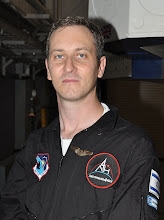 |
| Holding an "end of an era". Photo: Yanir Govrin |
Browsing through the magazine I found myself leaving behind our economical woes and the pause in U.S. human spaceflight and drifting into a future where there are too many spacecraft to count, where spaceflight is a frequent activity and where being a space tourist or researcher is as normal as being an engineer at a technology company.
There are many ads for universities, taking different approaches to show their importance or involvement in space. Some have made instruments for various missions, others have astronaut alumni. All are still excited about space and will continue to teach new generations of space engineers, scientists and enthusiasts.
Many space-industry companies are represented in the ads, companies that the layperson would never know about such as Comsol - makers of multiphysics simulation software, Vision Research - makers of high speed cameras used in both space missions and sports and Vacco who make propulsion components. There is an entire pyramid of space industry that's largely invisible and out of sight when space is discussed on general media, where NASA (in the U.S. at least) is still seen as holding the on/off master switch of spaceflight.
The cover title, "End of an era" theme reverberates throughout the magazine. An article by Neil Armstrong, Jim Lovell and Gene Cernan (three of the moon walkers) concludes:
Kennedy launched America on that new ocean. For 50 years we explored the waters to become the leader in space exploration. Today, under the announced objectives, the voyage is over. John F. Kennedy would have been sorely disappointed.While some articles discuss the future through topics such as space tourism, these almost seem like a fig leaf covering the self-shame of lack or end of "true" spaceflight to orbit and beyond. For me it is the ads which provide the real balance to the writers agenda and a glimpse of the future in this publication, a positive reminder for those of us outside of the space industry that it is not going anywhere. The road may look different and has some rocks added to it but there are plenty of Gs to be felt, by robots as well as people.

 Space Shuttle Launch Poll Results
Space Shuttle Launch Poll Results













1 comment:
Hopefully you remember the hollywood interested...
http://www.youtube.com/watch?v=lwINb2wc5Ns
Norman Copeland.
Post a Comment